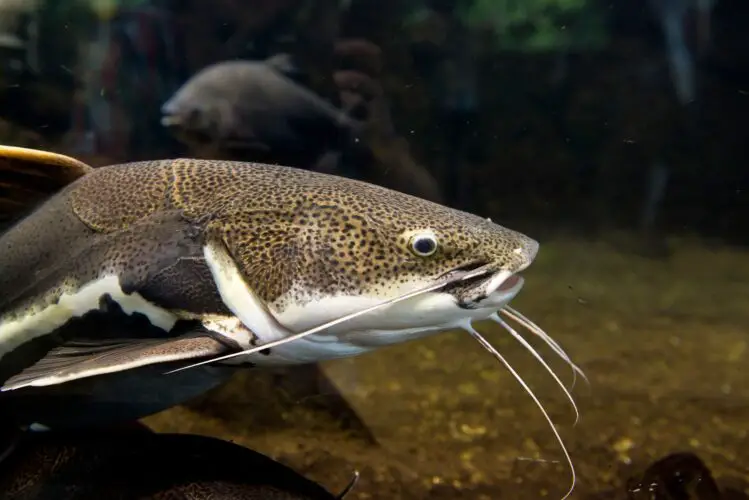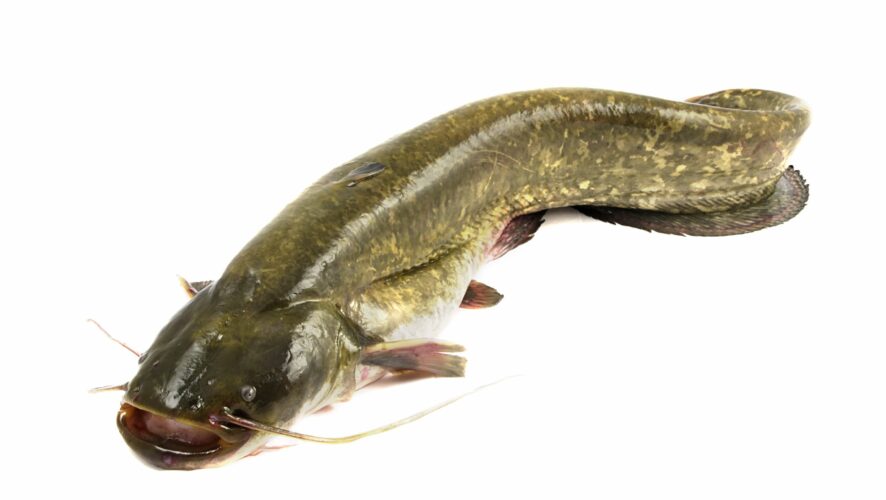There are differences between Catfish and Bullhead in terms of distribution, habitat, diet, appearance, taste, and many other factors. Though they belong to the same family, these differences arise due to their differences in the lower classification levels.

Classification difference between Catfish and Bullhead
Catfish and Bullhead are both freshwater fish in the same order. However, they belong to different taxonomic classifications for the lower levels.
Catfish, typically referring to the family Ictaluridae, are part of Siluriformes. It encompasses various species found worldwide. Their classification goes: kingdom Animalia, phylum Chordata, class Actinopterygii, order Siluriformes.
Bullheads, on the other hand, belong to the family Ameiuridae, and they are also within the order Siluriformes. But they represent a distinct family from Catfish due to their characteristic differences. The taxonomic classification of Bullheads includes the kingdom Animalia, phylum Chordata, class Actinopterygii, and order Siluriformes.
So, the primary difference lies in their family classification, Ictaluridae and Ameiuridae. These families have distinct characteristics and differences in morphology, behavior, and distribution, so the two fishes belong to entirely different genera and species.
Distribution difference between Catfish and Bullhead
There are notable differences in the distribution and habitat of the two fishes.
Catfish Distribution and Habitat
Catfish have a ubiquitous distribution and are found on multiple continents. This includes North America, South America, Asia, and Africa.
In North America, they are higher in number, with prominent species like the Channel Catfish found in the United States and Canada. In Asia, species like the walking catfish are located in countries like India, Thailand, and Indonesia. In the African continent, species such as the African Catfish exist in various countries.
As for habitat, Catfish are highly adaptable and, hence, can inhabit a range of freshwater environments. They are commonly found in rivers, lakes, ponds, and brackish waters and may be raised in aquariums. They prefer areas with slow-moving or still waters, primarily close to the bottom. As they are known for their scavenging behavior, you’ll often find them in murky or muddy waters, using their barbels to locate food.
Bullheads
Bullheads have a more limited distribution than Catfish, and their population is smaller. Instead of all continents, they are primarily found in North America.
The Brown Bullhead is common in the eastern and central United States and some parts of Canada. The Black Bullhead is found in various regions of North America, having a broader distribution compared to other bullhead species.
While Catfish can be found in all sizes of water bodies, bullheads are typically associated with smaller, shallow bodies of water. They prefer to hang around in slow-moving streams, ponds, and small rivers with muddy or sandy bottoms. Unlike some species of Catfish, bullheads are less likely to inhabit large, open bodies of water.
Bullheads also prefer quieter, weedy areas and are often found in areas with submerged vegetation. So they prefer a more sheltered body of water with a specific substrate compared to Catfish, which limits their distribution so much. It reflects their distinct ecological niches within the freshwater ecosystem.
Appearance difference between Catfish and Bullhead
The most significant difference between Catfish and Bullhead is their appearance. It’s pretty easy to distinguish them and tell them apart if you’re paying attention to the following factors:
Color
- Catfish: Catfish can exhibit a wide range of colors. It usually depends on their species and habitat. The most common colors include brown, gray, and yellow, often with mottled patterns.
- Bullhead: Bullheads are generally darker in color than Catfish. They are usually brown or black and may have mottled patterns like some catfish. However, their coloration is usually more uniform and subdued in comparison.
Body Shape
- Catfish: Catfish typically have a more elongated body, hosting a sleeker appearance. Though their body shape varies between species to an extent, it is often streamlined.
- Bullhead: Bullheads have a stockier and more compact body shape than Catfish. They are less streamlined and generally have a more rounded appearance.
Size
- Catfish: Catfish come in a wide range of sizes. Some species grow extremely large, such as the Mekong Giant Catfish.
- Bullhead: Bullheads are generally smaller fish. Most species average around 8 to 12 inches in length and grow less than the average catfish.
Barbels
- Catfish: Catfish are characterized by the prominent sensory barbels visible around their mouth. It helps them locate food in low-visibility waters.
- Bullhead: Bullheads also have barbels. But they tend to be shorter and less pronounced compared to Catfish.
Dorsal and Pectoral Spines
- Catfish: Catfish usually have sharp dorsal and pectoral spines, which they often use defensively. These spines can even be venomous in some species.
- Bullhead: Bullheads also have dorsal and pectoral spines, but like barbels, they are generally shorter and less likely to be venomous.
Fins
- Catfish: Catfish have a single adipose fin. It is soft and lacks fin rays. These fish have solid and sturdy fins, and the shape can vary among species.
- Bullhead: Bullheads also have an adipose fin, but for them, the dorsal fin is typically higher and more pointed than that of Catfish.
Mouth Size
- Catfish: Catfish often have larger mouths. This trait is adapted for their diverse feeding habits, including prey such as other fish, insects, and plant matter.
- Bullhead: Bullheads have relatively more minor mouths. It reflects their preference for bottom-dwelling prey.
Diet difference between Catfish and Bullhead
Catfish and Bullheads exhibit distinct differences in their diets and feeding habits. Here is a rundown of each:
Catfish
Catfish are omnivorous feeders and also opportunistic. Their diet is highly diverse and adaptable. It usually just reflects all the available food sources in their habitat. The most common components of a catfish’s diet include:
- Aquatic invertebrates: Catfish love to consume insects, crustaceans, and other marine invertebrates. They use their sensitive barbels to detect these small prey items in waters with restricted visibility.
- Small fish: Larger catfish species often prey on smaller fish. Sometimes, they may even feed on smaller Catfish.
- Plant matter: Catfish also include plant material in their omnivorous diet. This includes algae and aquatic plants. However, this is usually seen if animal prey is scarce.
- Carrion: Catfish are known for scavenging, so they feed on dead or decaying organisms.
- Detritus: Catfish often feed on detritus as well. This includes organic matter like decomposing leaves and other organic debris.
Bullheads
In contrast to Catfish, bullheads have a more specialized diet focusing on benthic or bottom-dwelling prey. Their feeding habits include:
- Aquatic invertebrates: Like Catfish, bullheads primarily feed on small marine invertebrates like insects, crustaceans, and mollusks. However, it’s limited to those found on or near the substrate at the bottom of bodies of water.
- Worms: Bullheads have a strong preference for worms. This includes aquatic annelids and insect larvae.
- Small fish and amphibians: Although less common, bullheads have also been found to consume small fish and amphibians when available.
- Detritus: Similar to Catfish, they consume detritus and other organic matter found in the sediment.
In summary, Catfish have a broader and more varied diet, including animal and plant material. Whereas bullheads have a more specialized preference for bottom-dwelling invertebrates, making them efficient hunters of benthic prey.
Feeding habit difference between Catfish and Bullhead
Catfish are typically nocturnal fish. They hunt and forage at night when many of their prey is active. Their ability to feed on various food sources makes them adaptable to various aquatic environments. They use their barbels to sense prey and taste food.
Bullheads are known for their bottom-feeding behavior. They also use their barbels to locate prey hidden in the substrate. They are less likely to scavenge for food and don’t consume a wide range of food sources like Catfish do.
Taste difference between Catfish and Bullhead
Catfish are more popular to consume compared to Bullhead, and that’s because of the distinct difference in their taste and flavor profile. Below is a detailed comparison of the taste of the two fishes:
Catfish Taste
Catfish is popular for its mild, sweet, and earthy flavor. The taste of Catfish is often described as clean and non-fishy, making it appealing to a wide range of taste palates. This flavor profile is influenced by the fish’s diet, which typically includes aquatic invertebrates, small fish, and plant material. This varied diet is what contributes to its mild, slightly sweet taste.
In terms of texture, Catfish has a firm yet tender flesh, so it feels good to chew on. The meat is white, moist, and flaky, making it suitable for various cooking methods. You can grill, fry, bake, or use Catfish in soups and stews. The soft flesh is known for absorbing flavors from seasonings and marinades, so it is a popular choice for seasoned dishes.
For comparison, other mild and sweet-flavored freshwater fish like tilapia and perch taste similar to Catfish. They share the mild, flaky texture that Catfish is known for. Hence, they can be used as alternatives.
Bullhead Taste
On the other hand, bullhead fish have a flavor that is often described as richer and somewhat gamier than catfish. It has a stronger and more pronounced fish taste. This can appeal to those who enjoy a bolder seafood flavor but differs from most people’s palates.
Their specialized diet also influences This kind of flavor, mainly consisting of benthic invertebrates, worms, and aquatic insects. Fishes like trout or mackerel have a similar taste to bullheads, although they are richer and have a slightly more distinctive taste.
In terms of texture, bullhead meat is also firm and flaky, but usually, they can be slightly denser compared to Catfish. It has pale and succulent meat.
In summary, Catfish tastes mild, sweet, and versatile, while Bullhead has a more robust, more pronounced fish flavor. Though Bullhead is less commonly consumed than Catfish, those who appreciate a more intense seafood taste may find it enjoyable for their palate.

Nutrition difference between Catfish and Bullhead
Catfish and Bullhead are nutritious options and are good sources of lean protein, vitamins, and minerals. They contain the same amount and types of vitamins and minerals but differ in other nutritional qualities.
It’s also worth noting that there may be variations in the nutrient profiles of each Catfish or each Bullhead based on habitat and diet. But the differences are generally minimal.
Catfish Nutrition (per 3-ounce cooked portion)
- Calories: It contains approximately 105 calories.
- Protein: It is an excellent source of protein, providing around 20-25 grams per serving.
- Fat: About 2-6 grams of fat exists in Catfish, which is relatively low. So, it is a lean source of protein.
- Omega-3 Fatty Acids: Catfish contains a small amount of omega-3 fatty acids. The levels are lower compared to some other fatty fish.
Bullhead Nutrition (per 3-ounce cooked portion)
- Calories: Lower than Catfish, around 80-100 calories.
- Protein: Bullhead offers about the same amount of protein as Catfish, around 18-22 grams per serving.
- Fat: The fat content can vary across specific fish but is generally similar to Catfish at about 2-6 grams.
- Omega-3 Fatty Acids: Bullhead contains moderate levels of omega-3, slightly higher than Catfish.
Both Catfish and Bullhead are relatively low in saturated fat, so eating them is suitable for individuals with heart conditions to improve their health. The protein content in both fish can also benefit diabetes patients as it can help regulate blood sugar levels.
Moreover, these fish’s vitamin D, phosphorus, and magnesium can contribute to overall bone health. Both fish are low in calories and fat, making them a good choice for those seeking weight management.
In conclusion, there are many notable differences between Catfish and Bullheads, but both are prized fishes for anglers!











